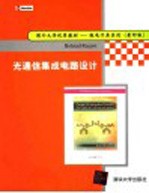

光通信集成电路设计PDF电子书下载
- 电子书积分:13 积分如何计算积分?
- 作 者:罗扎威(Razavi,B.)著
- 出 版 社:北京:清华大学出版社
- 出版年份:2005
- ISBN:7302107203
- 页数:364 页
ContentS 1
1 Introduction to Optical Communications 1
1.1 Brief History 1
1.2 Generic Optical System 2
1.3 Design Challenges 5
1.4 State of the Art 6
2 Basic Concepts 8
2.1 Properties of Random Binary Data 8
2.2 Generation of Random Data 12
2.3 Data Formats 14
2 3 1 NRZ and RZ Data 14
2 3.2 8B/10B Coding 14
2.4 Effect of Bandwidth Limitation on Random Data 16
2.4 1 Effect of Low-Pass Filtering 16
2.4 2 Eye Diagrams 16
2 4.3 Effect of High-Pass Filtering 18
2 5 Effect of Noise on Random Data 21
2 6.1 Phase Noise 24
2.6 Phase Noise and Jitter 24
2 6 2 Jitter 27
2 6 3 Relationship Between Phase Noise and Jitter 28
2.6.4 Jitter Due to Additive Noise 28
2.7 Transmission Lines 30
2 7 1 Ideal Transmission Lines 30
2.7 2 Lossy Transmission Lines 33
3.1 Laser Diodes 36
3 Optical Devices 36
3 1 1 Operation of Lasers 38
3.1.2 Types of Lasers 40
3.1 3 Properties of Lasers 42
3.1.4 Extemal Modulation 45
3.2 Optical Fibers 46
3.2.1 Fiber Loss 47
3.2.2 Fiber Dispersion 48
3 3.1 Responsivity and Efficiency 55
3.3 Photodiodes 55
3.3.2 PIN Diodes 56
3.3 3 Avalanche Photodiodes 57
3.4 Optical Systems 58
4 Transimpedance Amplifiers 62
4.1 General Considerations 62
4.1.1 TIA Performance Parameters 64
4 1 2 SNR Calculations 69
4.1.3 Noise Bandwidth 72
4.2 Open-Loop TIAs 73
4.2.1 Low-Frequency Behavior 73
4.2 2 High-Frequency Behavior 81
4.3 Feedback TIAs 87
4.3 1 First-Order TIA 87
4.3.2 Second-Order TIA 89
4 4 Supply Rejection 97
4.5 Differential TIAs 100
4.6.1 Gain Boosting 103
4.6 High-Performance Technques 103
4.6 2 Capacitive Coupling 105
4.6.3 Feedback TIAs 106
4.6 4 Inductive Peaking 110
4.7 Automatic Gain Control 114
4.8 Case Studies 118
5 Limiting Amplifiers and Output Buffers 123
5.1 General Considerations 123
5.1.1 Performance Parameters 123
5.1 2 Cascaded Gain Stages 125
5.1.3 AM/PM Conversion 129
5.2 Broadband Techniques 131
5.2.1 Inductive Peaking 131
5.2.2 Capacitive Degeneration 133
5.2.3 Cherry-Hooper Amplifier 136
5.2.4 fT Doublers 140
5.3 Output Buffers 142
5 3 1 Differential Signaling 142
5.3.2 Double Termination 146
5.3.3 Predriver Design 149
5.4 Distributed Amplification 152
5.4.1 Monolithic Transmission Lines 152
5.4.2 Distributed Amplifiers 156
5.4.3 Distributed Amplifiers with Lumped Devices 163
6 Oscillator Fundamentals 165
6.1 General Considerations 165
6.2 Ring Oscillators 167
6.3 LC Oscillators 178
6.3.1 Crossed-Coupled Oscillator 181
6.3.2 Colpitts Oscillator 184
6.3.3 One-Port Oscillators 187
6.4 Voltage-Controlled Oscillators 191
6.4.1 Tuning in Ring Oscillators 194
6.4.2 Tuning in LC Oscillators 202
7 LC Oscillators 208
7.1 Monolithic Inductors 208
7.1.1 Loss Mechanisms 210
7.1.2 Inductor Modeling 214
7.1.3 InductorDesign Guidelines 217
7.2 Monolithic Varactors 221
7.3 Basic LC Oscillators 223
7.3.1 Differential Control 226
7.3.2 Design Procedure 228
7.4 Quadrature Oscillators 230
7.4.1 In-Phase Coupling 232
7.4.2 Antiphase Coupling 234
8 Phase-Locked Loops 238
8.1 Simple PLL 238
8.1.1 Phase Detector 238
8.1.2 Basic PLL Topology 239
8.1.3 Dynamics of Simple PLL 248
8.2 Charge-Pump PLLs 254
8.2.1 Problem of Lock Acquisition 255
8.2.2 Phase/Frequency Detector and Charge Pump 256
8.2.3 Basic Charge-Pump PLL 260
8.3.1 PFD/CP Nonidealities 267
8.3 Nonideal Effects in PLLs 267
8.3.2 Jitter in PLLs 271
8.4 Delay-Locked Loops 274
8.5 Applications 276
8.5.1 Frequency Multiplication and Synthesis 277
8.5.2 Skew Reduction 279
8.5.3 Jitter Reduction 280
9.1 General Considerations 282
9 ClockandDataRecovery 282
9.2 Phase Detectors for Random Data 294
9.2.1 Hogge Phase Detector 294
9 2 2 Alexander Phase Detector 298
9.2.3 Half-Rate Phase Detectors 303
9.3 Frequency Detectors for Random Data 307
9.4 CDR Architectures 312
9.4.1 Full-RateReferencelessArchitecture 312
9.4.2 Dual-VCO Architecture 313
9.4.3 Dual-LoopArchitecturewithExternalReference 315
9.5 Jitter in CDR Circuits 316
9.5.1 Jitter Transfer 316
9.5.2 Jitter Generation 321
9.5.3 Jitter Tolerance 323
10 Multiplexers and Laser Drivers 327
10.1 Multiplexers 327
10.1.1 2-to-1 MUX 327
10.1.2 MUX Architectures 332
10.2 Frequency Dividers 335
10.2.1 Flipflop Dividers 335
10.2.2 Miller Divider 343
10.3 Laser and ModulatorDrivers 345
10.3.1 Performance Parameters 345
10.4 Design Principles 349
10.4.1 Power Control 355
Index 357
- 《女丹仙道:道教女子内丹养生修炼秘籍 下》董沛文著 2012
- 《计算机网络与通信基础》谢雨飞,田启川编著 2019
- 《民国时期医药卫生文献集成 37》路丽明编 2019
- 《民国时期医药卫生文献集成 19》路丽明编 2019
- 《民国时期医药卫生文献集成 24》路丽明编 2019
- 《集成曲谱金集 卷7 卷8》黄天骥总主编;王季烈,刘富梁辑 2018
- 《通信电子电路原理及仿真设计》叶建芳 2019
- 《民国时期医药卫生文献集成 13》路丽明编 2019
- 《中国大运河历史文献集成 7》王云,李泉主编 2014
- 《民国时期医药卫生文献集成 16》路丽明编 2019
- 《中风偏瘫 脑萎缩 痴呆 最新治疗原则与方法》孙作东著 2004
- 《水面舰艇编队作战运筹分析》谭安胜著 2009
- 《王蒙文集 新版 35 评点《红楼梦》 上》王蒙著 2020
- 《TED说话的力量 世界优秀演讲者的口才秘诀》(坦桑)阿卡什·P.卡里亚著 2019
- 《燕堂夜话》蒋忠和著 2019
- 《经久》静水边著 2019
- 《魔法销售台词》(美)埃尔默·惠勒著 2019
- 《微表情密码》(波)卡西亚·韦佐夫斯基,(波)帕特里克·韦佐夫斯基著 2019
- 《看书琐记与作文秘诀》鲁迅著 2019
- 《酒国》莫言著 2019
- 《大学计算机实验指导及习题解答》曹成志,宋长龙 2019
- 《指向核心素养 北京十一学校名师教学设计 英语 七年级 上 配人教版》周志英总主编 2019
- 《大学生心理健康与人生发展》王琳责任编辑;(中国)肖宇 2019
- 《大学英语四级考试全真试题 标准模拟 四级》汪开虎主编 2012
- 《大学英语教学的跨文化交际视角研究与创新发展》许丽云,刘枫,尚利明著 2020
- 《北京生态环境保护》《北京环境保护丛书》编委会编著 2018
- 《复旦大学新闻学院教授学术丛书 新闻实务随想录》刘海贵 2019
- 《大学英语综合教程 1》王佃春,骆敏主编 2015
- 《大学物理简明教程 下 第2版》施卫主编 2020
- 《指向核心素养 北京十一学校名师教学设计 英语 九年级 上 配人教版》周志英总主编 2019
